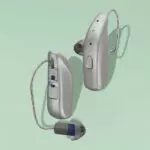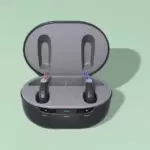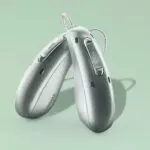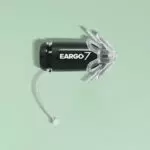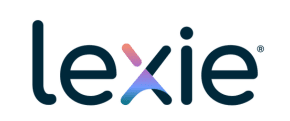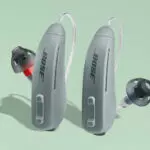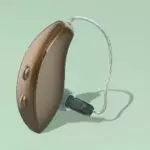Table of Contents
- We spent over 7,500 hours researching dozens of hearing aids and using a 25-question checklist to identify standout contenders. Then, our team personally tested 27 of the most popular and highly rated devices.
- Our testers mystery shopped hearing aids from 11 brands and then began testing them focusing on the set up and adjustment process, what it was like to wear the devices, and how they performed in terms of comfort, sound quality, and ease of use. We also tested charging and/or battery replacement, routine maintenance, and applicable apps.
- We interviewed 26 people who wear hearing aids to identify important factors to consider when shopping for these devices.
- We also consulted with 17 experts on key factors for hearing aids.
- Our pages are regularly revisited to update pricing and service information and reflect our ongoing testing of new hearing aids.
Key Takeaways
- With its exceptional audio quality and affordability, the Jabra Enhance is our pick for the best hearing aid overall.
- Based on our research, we’ve learned that the average cost of OTC hearing aids ranges between $500 and almost $3,000. For prescription hearing aids, you can expect to pay between $2,300 and $5,450 per pair.
- Our team consulted with hearing professionals for their insights and performed hands-on testing to inform our recommendations, which are based on considerations like battery life, Bluetooth connectivity, comfort, sound quality, ease of use, and cost.
Experts tell us the average person in the United States waits about 10 years to seek help after learning they have hearing loss. Unfortunately, hearing loss has been linked to higher rates of Alzheimer’s disease (a type of dementia), social isolation, and depression, but hearing aids can help. The affordable and discreet hearing aids on the market today make the decision to wear them easier. Using our thorough research and testing process, we regularly evaluate hearing devices. Here are the best hearing aids available today.
Hearing aid users now have the option of purchasing their devices over the counter (OTC) or prescribed by a physician. While OTC hearing aids are an excellent option for those with mild-to-moderate hearing loss, those with complex or more severe hearing loss benefit more from prescription hearing aids. Using our thorough research and testing process, we regularly evaluate hearing devices to ensure we’re recommending the best on the market. Whether you’re looking for an OT or a prescription hearing aid, here are the best hearing aids available today.
9 best hearing aids of 2024
Think about your hearing needs, budget, lifestyle, and preferences before choosing a hearing aid. With those factors in mind, take a look at our top picks for the best hearing aids on the market.
- Jabra Enhance: Our top pick
- Audien: Low prices and simple features
- Phonak Audéo Lumity: Best prescription
- Eargo: Best invisible fit
- hear.com: Best high-tech
- Lexie: Most user-friendly app
- MDHearing: Lowest starting cost
- Starkey Genesis AI: Longest battery life
- Oticon Real: Best sound quality
Jabra Enhance: Our top hearing aid pick
Why Jabra Enhance is our top pick
Jabra Enhance makes the best all-around OTC hearing aids on the market due to their impressive sound quality, Bluetooth streaming in every device, and stellar customer service. Jabra Enhance hearing aids also stand out for their lengthy battery life and user-friendly design. Since Jabra gives users a premium experience from the initial self-fitting to the ongoing customer support, it’s a clear choice for our top pick.
Jabra Pros & Cons
Jabra Enhance tester insights
Jabra Enhance is a leader in the OTC hearing aid market for good reason. Among OTC hearing aids, we’ve found the company offers the best sound technology and features, along with customer service that’s prompt, friendly, and knowledgeable every time we contact them.

Jabra Enhance makes one earbud-style hearing aid, called Jabra Enhance Plus, a receiver-in-canal device, the Enhance Select 50R, one mini receiver-in-ear device, the Enhance Select 300, and a micro receiver-in-the-ear device, the Enhance Select 500. You can also find one prescription model, the Jabra Enhance Pro, at Costco hearing centers. Because the Pro doesn’t come with remote support and has different pricing and features, we chose to test only Jabra Enhance OTC hearing aids for this review.
The Enhance Plus is great for active people who want a device that looks like a pair of earbuds rather than hearing aids. Our testers noted how their hearing improved when using them, but background noise wasn’t as quiet as with the Enhance Select models.
Another perk was how easy the Enhance Plus was to use. Charging, adjusting, and cleaning were smaller chores than they were with many hearing aids. The design was user-friendly, too, with a comfortable fit and prominent buttons for adjusting the volume and settings.
From one of our Jabra testers
“The buttons on this device are large and easy to push, compared to the tiny, stiff buttons on some hearing aids. I also like that the charger has strong magnetic charging ports to ensure a good connection.”
Enhance Select hearing aids are designed with more advanced sound processing capabilities than the Plus, with the Enhance Select 300 offering technology comparable to a basic prescription hearing aid and the Enhance Select 500 offering even more advanced technology. Among customers who purchased Jabra Enhance hearing aids in our survey of 600 hearing aid users under the age of 45, an impressive 97 percent said their hearing aids had somewhat or significantly improved their quality of life.
When evaluating Enhance Select hearing aids, our testers found their design, which sits behind the ear, even less noticeable than the earbud-style Enhance Plus.
From one of our Jabra testers
“The Select 300 is very comfortable. In fact, I thought I misplaced it but it turned out to still be in my ear.”
To learn more, read our in-depth Jabra review.
Audien: Most affordable hearing aids
Why Audien is our most affordable pick
Audien is the best choice for people looking for affordable hearing aids with simple features. It has the lowest cost out of all of our picks but still delivers a high-quality product, an unlimited protection plan, and enhanced feedback cancellation. Our testers preferred the Audien Atom Pro 2 hearing aids, which offer a comfortable fit and a portable charging case with built-in UV light sanitizing.
Audien Pros & Cons
Audien tester insights
Of all the Audien hearing aids we tested, our testers liked the Atom Pro 2 best, saying it felt comfortable and secure in their ears and was easier to maintain and clean compared to the Atom 2, thanks to the newly added UV light sanitizing case. We also like that the new charging cases can be fully closed and are now powered by USB-C, making them much more on-the-go and user-friendly.
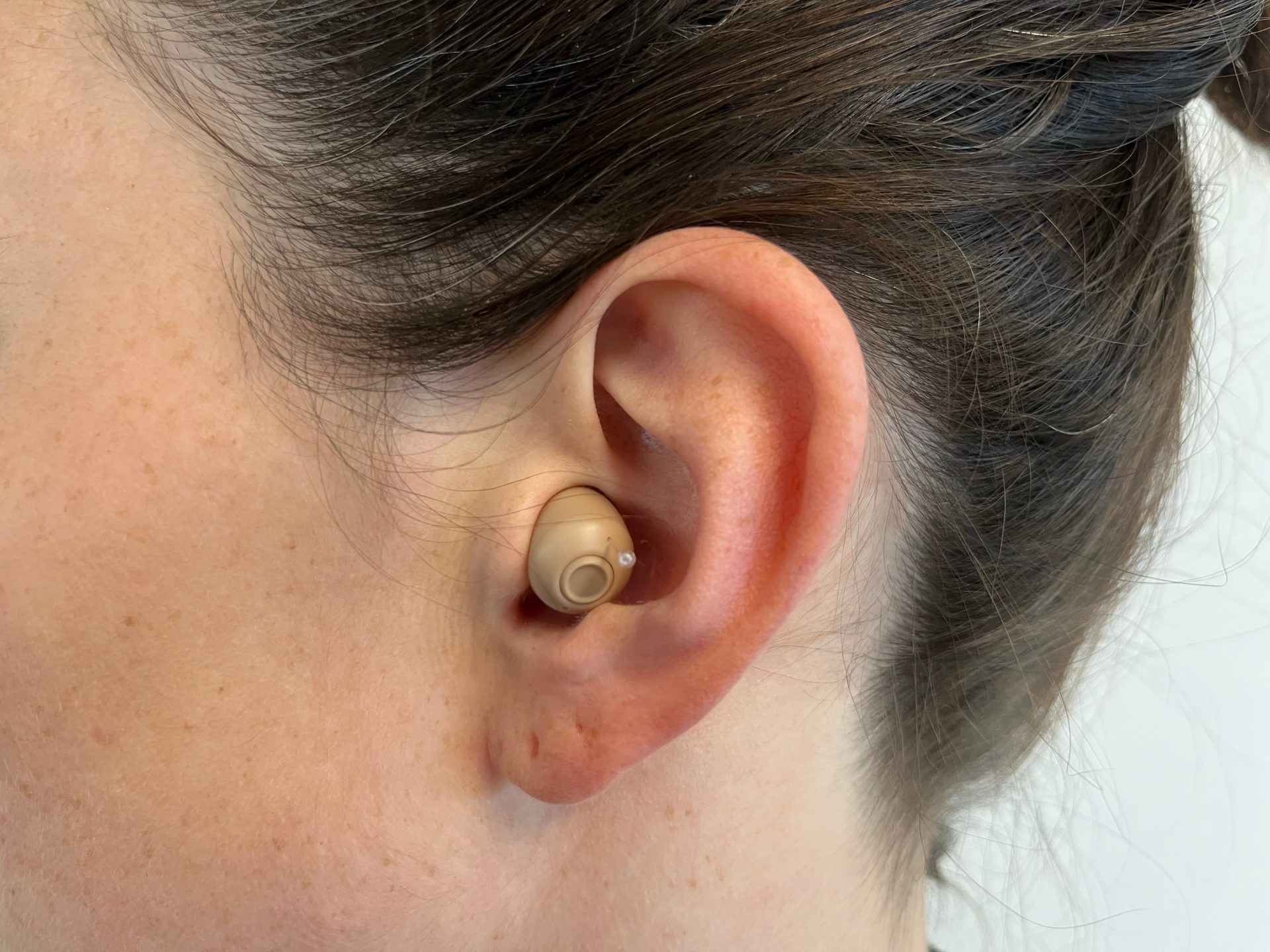
Audien does not provide post-purchase audiology support, but our call to customer service was answered promptly. There’s also a live chat function on the Audien website for device support, but when testing the feature, we received an automated message with a wait-time of several hours before our question was answered.
Audien sells a behind-the-ear model for just under $500, but it doesn’t offer Bluetooth streaming. Because we have found similarly priced hearing aids with more features, we don’t recommend the Audien BTE.
Learn more in our Audien review.
Phonak Audéo Lumity: Best prescription hearing aids
Why Phonak is our pick for best prescription
Phonak Audéo Lumity uses the brand’s unique technology to automatically adjust to your environment so you can hear no matter where you are, making it a great choice for those requiring a prescription hearing aid. The Phonak Audéo Lumity is an ideal option for people who need help hearing in classrooms, auditoriums, and other large public spaces because Phonak offers a variety of accessories for challenging listening environments. Additionally, the devices’ exceptional Bluetooth technology allows you to stream everything from TV shows to phone calls directly to your hearing device.
Phonak Pros & Cons
Phonak tester insights
During testing, we loved the comfortable fit of the Audéo Lumity. One of our team members said, “This hearing aid is very comfortable and ergonomic. It honestly felt like it clicked right into place.” The multifunction button on the outside of the hearing aid, which you use to cycle between programs, makes phone calls, controls Bluetooth, and is cleverly placed on the top of the hearing aid, so when the user presses the button, the device stays firmly in the ear.
From one of our Phonak testers
“Using the buttons on the exterior of the hearing aids was much easier than other brands. The multifunction button is higher on the outside of the hearing aid, so when you press the button to change settings, it doesn’t destabilize the hearing aids in your ears like other brands do.”
We also enjoyed testing the health tracking features accessible through the Phonak app, which include heart rate monitoring, steps walked, and daily hearing aid use. On the flip side, the manual wasn’t user-friendly or easy to follow.
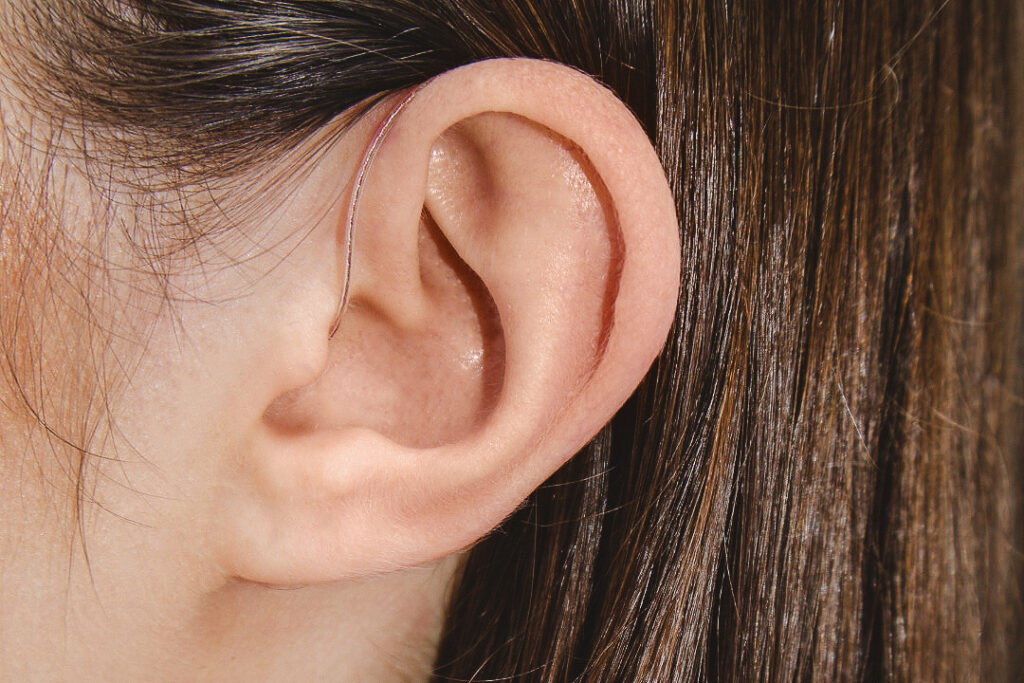
Keep in mind that the Phonak Audéo Lumity, like all prescription hearing aids, is meant to be programmed and set up by an audiologist in a hearing care clinic. If you run into issues, you can watch how-to videos in the app or contact your audiologist for help.
Eargo: Best hearing aids for an invisible fit
Why Eargo is our pick for an invisible fit
Eargo is the winner for the best invisible hearing aid among OTC brands. Despite their small size, Eargo hearing aids offer impressive features, including models with Bluetooth streaming, customizable hearing settings, and sound adjust options to offer better clarity in noisy environments. We also like that Eargo hearing aids can be used right out of the box with the option to adjust the settings yourself or with one of the company’s virtual hearing professionals.
Eargo Pros & Cons
Eargo tester insights
From one of our Eargo testers
These are comfortable, and I think they give a less plugged feeling than many other CIC or ITE devices.
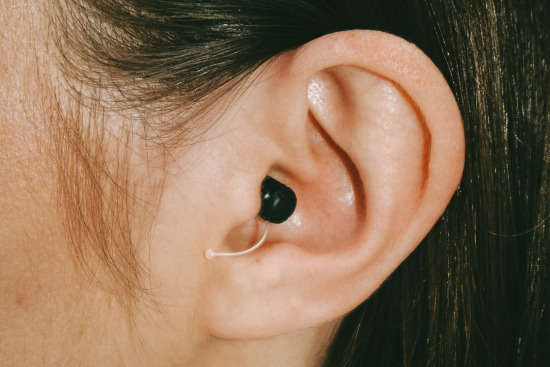
We didn’t love the sound quality of Eargos compared to prescription devices, but they were better than some other OTC brands. Our testers noticed that background noise was distracting at times, making it harder to understand conversations.
Another drawback of Eargo is that the devices are too small to accommodate Bluetooth streaming, so if you want that option, you’ll need to look at other OTC brands like Jabra Enhance. All prescription brands offer Bluetooth streaming as well.
We did like several features of Eargo that many other OTC devices don’t offer. For instance, you can change programs to select a different listening setting by simply tapping on your ear. This is easier than pushing a button on the hearing aid. But strangely, you have to use the app to adjust the volume, which took some getting used to.
From one of our Eargo testers
“It’s confusing that you can’t change the volume on the hearing aid, but you can change the program.”
The Eargo 6 and 7 both offer Sound Adjust, a feature that enables them to change the amplification of speech and background noise to accommodate your movements. They’re also water-resistant, and the 7 has added sweat resistance as well. This makes both models a great choice for active people.
Learn more in our Eargo review.
hear.com: Best high-tech hearing aids
Why hear.com is our pick as the best high-tech
For those who prioritize tech and convenience, hear.com’s hearing aids are worth considering. However, this online platform isn’t suitable for those with profound hearing loss. Because everything is done online, procedures like real-ear verification aren’t possible. Plus, you can also receive other brands of hearing aids while using hear.com’s online consultations.
hear.com Pros & Cons
hear.com tester insights
hear.com sells hearing aids from many different brands, but this company also produces its own line called Horizon. Horizon hearing aids are a good choice for individuals with mild to moderate hearing loss.
hear.com’s telehealth platform makes getting hearing aids refreshingly convenient. The initial at-home hearing test is free, and virtual appointments with licensed professionals streamline the fitting process.
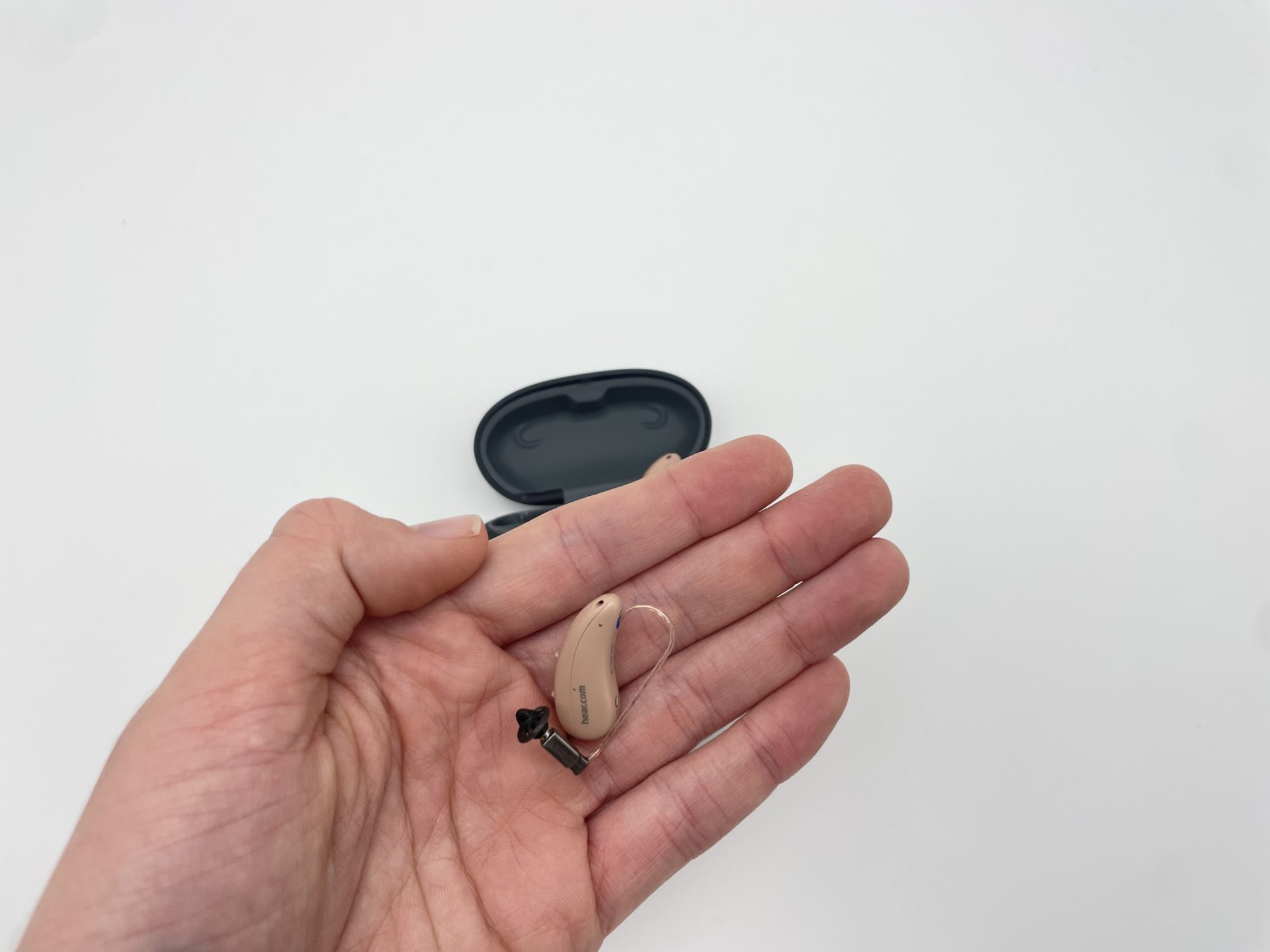
One of the most unique aspects of hear.com is the ability to test your hearing aids at home with their testing kit. Our tester felt hear.com made the process simple and clear. When she received the kit, she found easy-to-follow, on-screen instructions. Setup involves connecting a tablet, downloading an app to your smartphone, and plugging in various components. During the virtual appointment, the audiologist performs the hearing test and remotely sets up the hearing aids, explaining everything from maintenance to using the app and cleaning the devices.
From one of our hear.com testers:
“Everything I needed was in the box- the tablet, a camera with a light that goes in my ear, different dome sizes, headphones for the hearing test, and the hearing aids themselves. The doctor walked me through everything from start to finish, and it was truly a seamless experience.”
While the kit is comprehensive, it’s important to note that there are a lot of parts. One tester mentioned it felt a bit overwhelming at first. However, upon taking the time to sort out what’s needed, they learned it wasn’t overly complicated. It’s worth noting that some components, like the small domes, can be tricky to manage, especially for those with dexterity issues.
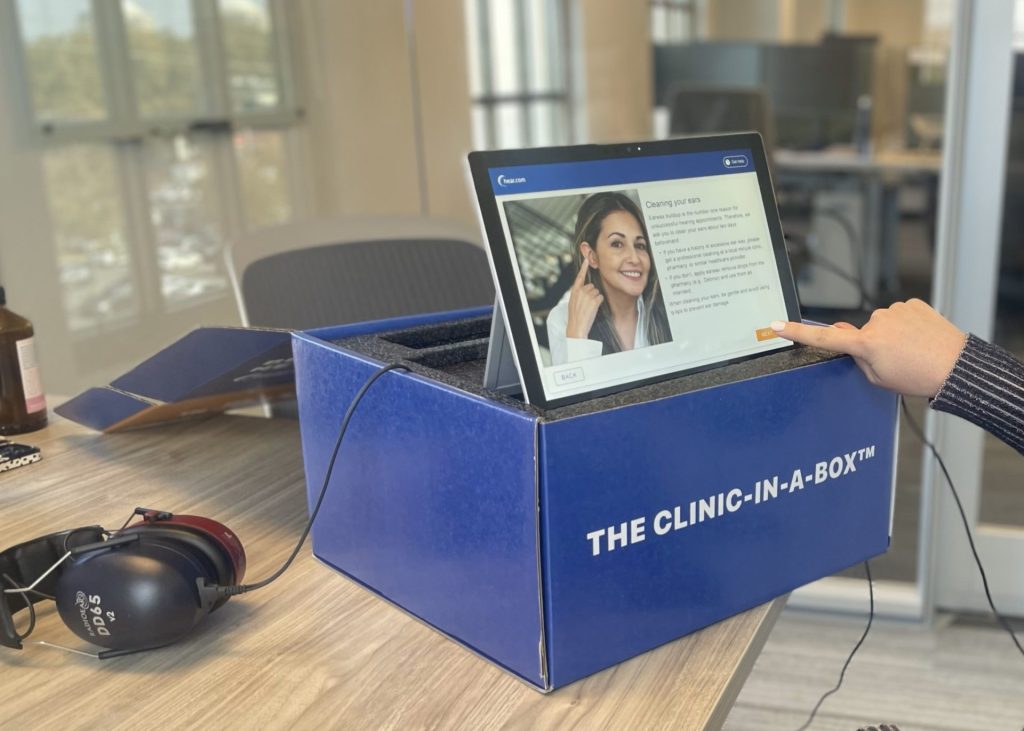
Lexie: Most user-friendly hearing aid app
Why Lexie is our pick for most user friendly app
Lexie offers lifetime audiology support and the best OTC hearing aid app on the market. With three self-fitting hearing aids, Lexie’s products include a wide range of features, including Bluetooth connectivity, impressive sound quality, and competitive pricing.
Lexie Pros & Cons
Lexie tester insights
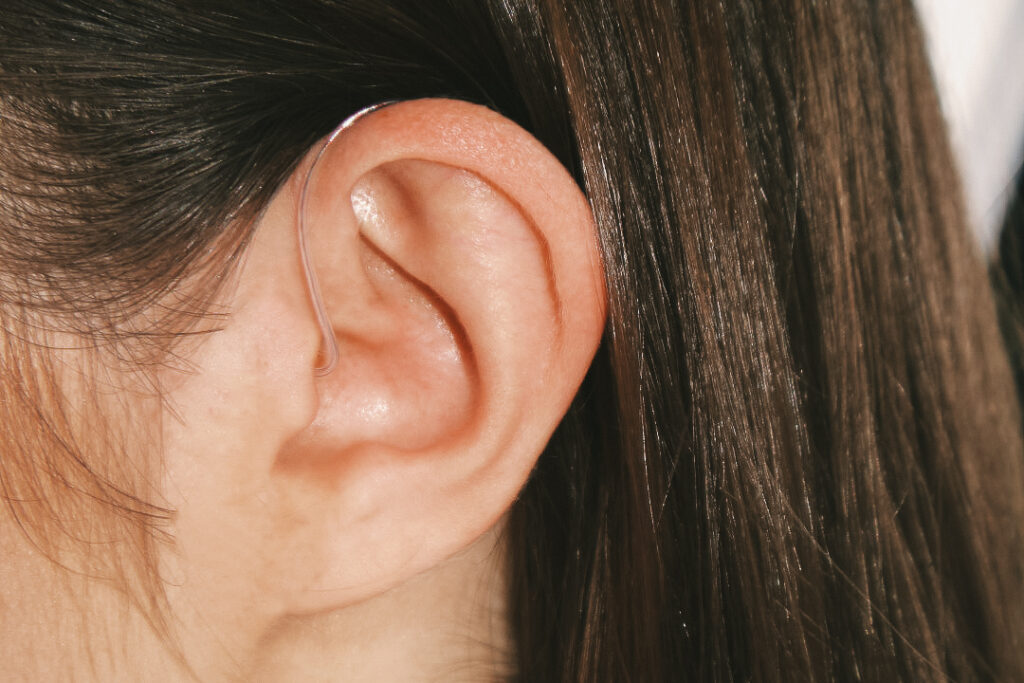
We found all three Lexie hearing aids had good sound quality, and we were impressed with the Lexie app, which walks you step-by-step through the setup process and hearing screen, demonstrating everything more clearly than most other hearing aid apps. This is really important with OTC hearing aids, which are meant to be fitted and adjusted by the user without professional help.
From one of our Lexie testers
“The app has a really handy walk-through feature with videos, images, and diagrams for how to fit your hearing aid correctly. It’s much better than other hearing aid apps.”
You can do all of the following from the Lexie app:
- Watch videos on how to set up and adjust your hearing aids.
- Change volume and listening settings.
- Order hearing aid supplies.
- Read articles and watch tutorials on hearing loss, hearing aid use, and ways to troubleshoot issues.
- Contact audiology or general customer support.
- Earn and redeem rewards for wearing your hearing aids consistently.
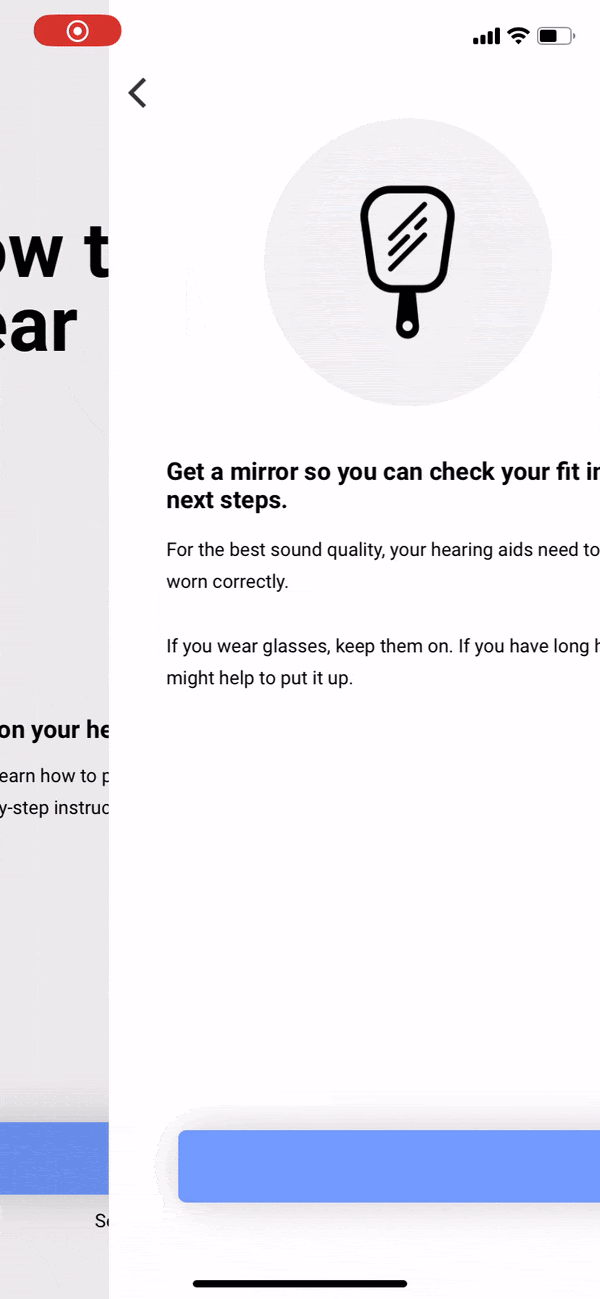
We did find some drawbacks with Lexie. Changing the batteries in the Lumen and B1 was inconvenient since both the battery door and the batteries are tiny and could be hard to manage for people with dexterity issues. If you drop them, they’re nearly impossible to find.
We also didn’t like the user manual. A few of the instructions were confusing, and the manual was long and hard to follow. Most other OTC hearing aid manuals are shorter, easier to use, and have larger text and more pictures.
While you can make hands-free calls with the B2 Plus, Lexie doesn’t offer Bluetooth audio streaming. The sound quality also isn’t as great as what you’ll find in Jabra Enhance, but we still were impressed with the audio.
From one of our Lexie testers
“The B2 iPhone call streaming was intuitive to set up, and streaming audio was easy. The Made for iPhone call quality was super strong and clear.”
MDHearing: Lowest starting cost hearing aids
Why MDHearing is our pick for lowest starting cost
MDHearing is one of the only OTC hearing aid companies to offer a free audiology consult before purchasing its products and unlimited post-purchase audiology support at an affordable price. With four different models, each offering their own range of features, MDHearing has an option for every user. Additionally, with the brand’s generous sales, you can often find a high-quality MDHearing device for a fraction of the retail price.
MDHearing Pros & Cons
MDHearing tester insights

We found MDHearing devices comfortable to wear and easy to set up. Testers appreciated the small size and comfort of Neo XS, noting it did not fall out when shaking their heads. One tester commented that Neo XS is good for people who have limited experience with technology.
But we didn’t like how the buttons used to make adjustments on the Neo and Air 3 were small and hard to push. The devices were also noisy when taking them out of our ears.
The tester who used the Volt Max experienced continuous whistling, even after emailing photos to the MDHearing audiologist to ensure he had the right fit. We found the same problem with the Air 3 during our testing.
“The Air 3 often whistles as I’m inserting it into my ears and taking it out,” said one tester. “It can even be painful because it’s very loud.”
From one of our MDHearing testers
“The ports in the charging case are very strong, and it’s easy to snap the hearing aids into place for charging. If the aid isn’t fully clicked in, the green light doesn’t turn on.”
A big benefit of this brand is the company’s unlimited audiology support, which is something that many hearing clinics don’t even offer. We also like how you can take a free online hearing test and schedule a free remote consultation with an audiologist, something that no other brand provides.
Starkey Genesis AI: Longest hearing aid battery life
Why Starkey Genesis AI is our pick for longest battery life
The Starkey Genesis AI has one of the longest-lasting rechargeable batteries in the industry, with 51 hours of use from a single charge. Additionally, Starkey’s advanced AI technology scans your environment and auto-adjusts your sound to ensure superior clarity.
Starkey Pros & Cons
Starkey tester insights
We found the manual easier to use and understand than those from Phonak or Oticon, a point that’s especially important for people who are new to hearing aids. “It’s surprisingly easy to use for a prescription hearing aid manual,” said one tester. Because your audiologist sets up prescription devices, their manuals seem to be written for hearing professionals rather than customers. But, some customers will want to read through their manuals at home after having their hearing aids fitted in the clinic, and we appreciated the clear language and directions in the Starkey manual.
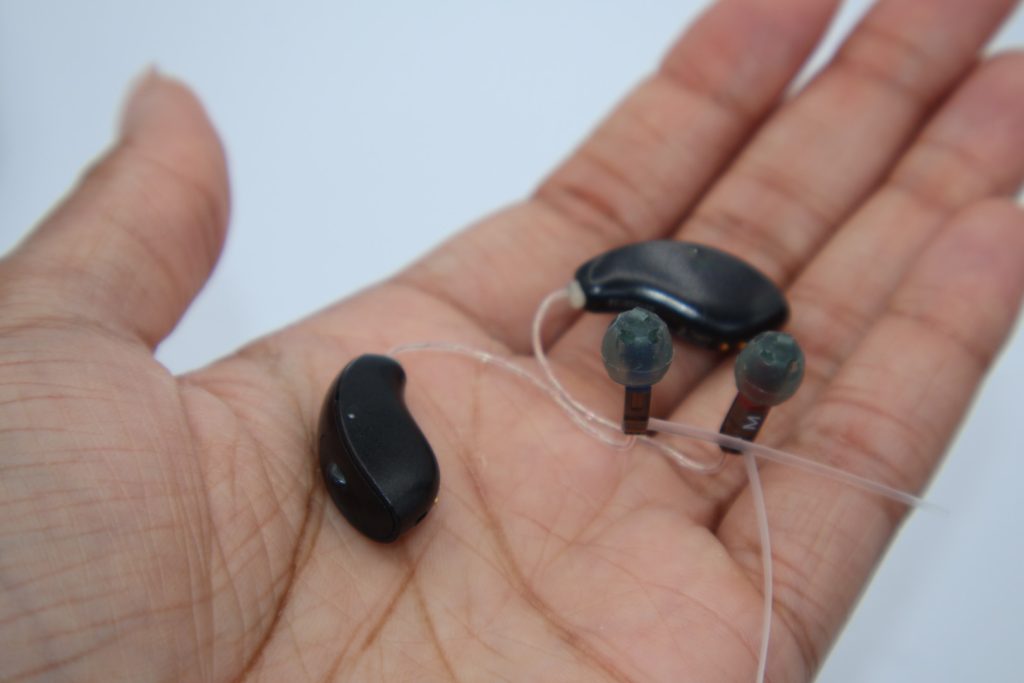
The Starkey Genesis AI also has a newly designed app we liked using better than the old version. However, it could be overwhelming for someone who doesn’t use a smartphone often or who doesn’t need all the health features offered with this device.
From one of our Starkey testers
“The app is very easy to navigate, but it also includes a lot of information. I like the activity tracking and the ability to add goals and fall alerts. Hear Share, a caregiver network that can send alerts to loved ones, is also a great feature.”
All prescription hearing aids come in several technology levels, which is why you see a price range for each model. Stefanie Godbey, an audiologist in Cincinnati, Ohio, says the cost will vary based on the technology level each patient needs and wants. Some people will choose lower-end devices that cost less, while others will be happier and hear better with more advanced hearing aids.
Higher-end instruments can reduce more background noise than the mid- or low-level instruments. When you compare even basic prescriptive technology to what we had 15 or 20 years ago, it’s light years ahead. But there is a huge difference between lower-end and higher-end instrumentation.
Stefanie Godbey, AuD
Oticon Real: Best sound quality hearing aids
Why Oticon Real is our pick for best sound quality
The Oticon Real was the best-performing hearing aid we tested in terms of sound quality and background noise reduction. With a comfortable fit, exceptional audio processing, and sound stabilizing technology that reduces wind and handling noise, Oticon Real is one of our top performers for prescription hearing aids.
Should you buy Oticon Real?
“The app is very easy to navigate, but it also includes a lot of information. I like the activity tracking and the ability to add goals and fall alerts. Hear Share, a caregiver network that can send alerts to loved ones, is also a great feature.”
Oticon Real Pros & Cons
Oticon Real tester insights
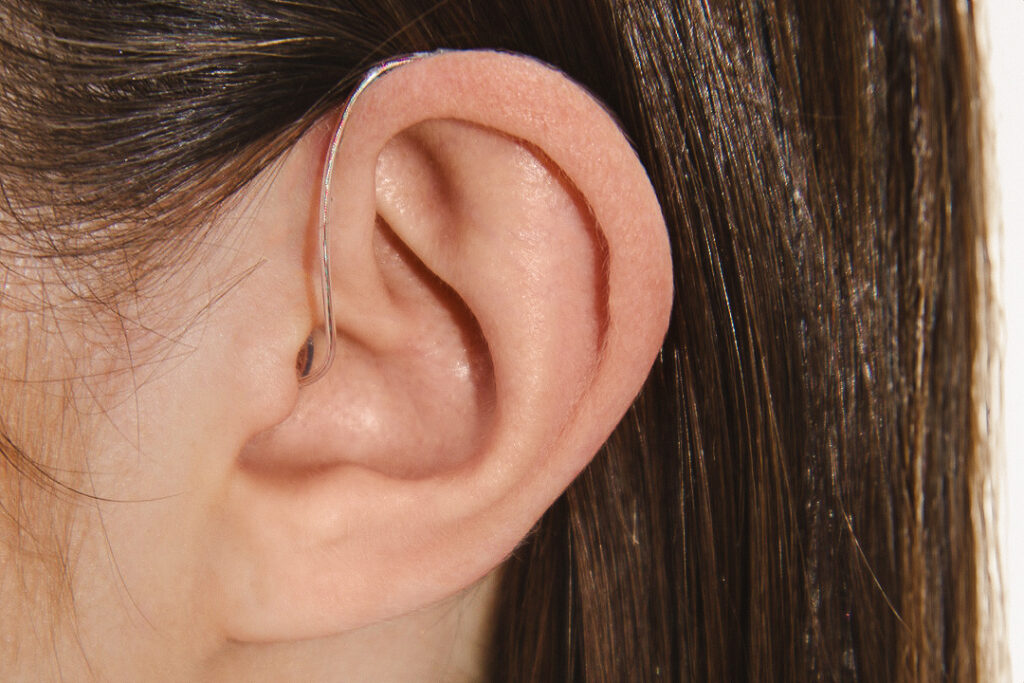
One common annoyance among hearing aid users is static when handling the hearing aids, touching their eyeglasses, or brushing their hair. The Real has detectors that sense these movements and reduce noise interference, so conversations aren’t disrupted. We loved this feature, along with the seamless listening experience while moving from quiet to loud rooms.
From one of our Oticon testers
“The sound quality is not harsh at all, and this is just right out of the box without any programming. There is still some light background noise, but the sound is very smooth. The quality is immediately and obviously better than OTC models.”
The Oticon Real app also includes a remote microphone function, which picks up sound from your phone and transmits it to your hearing aids, even when you’re in a different room. We think this feature could be great for students or people who need to hear someone speaking in a conference room or auditorium.
From one of our Oticon testers
“The remote microphone is very precise. I could hear clearly what people were saying from across the office when they were speaking near my phone.”
Other hearing aid brands to consider
We prioritize providing the best possible recommendations for your hearing health. That’s why we thoroughly test a wide range of hearing aids, and only the ones that meet our high standards for sound quality, features, and user experience make it onto our list.
Audicus offers a range of self-fitting hearing aids designed for individuals with mild to severe hearing loss. They focus on providing a convenient and affordable solution through their online platform, allowing users to skip the traditional audiologist visit and purchase hearing aids directly.
- Audicus boasts some of the most competitive prices on the market, with hearing aids starting around $699 per ear.
- While features vary by model, Audicus hearing aids typically include basic to advanced noise reduction, directional microphones, and telecoil (on some models) for improved sound quality in public settings with loops.
- Audicus offers multiple hearing aid models (Mini, Wave 2, B1, B2 Plus) to suit different needs and budgets.
Audicus is a solid option for those seeking a budget-friendly hearing aid solution. Their self-fitting process and online support system are convenient, and their hearing aids offer good sound quality at an attractive price point. However, it’s important to consider that Audicus hearing aids lack some advanced features found in higher-end options, and they may not be suitable for everyone, particularly those with complex hearing needs.
Sony brings its trusted reputation for quality electronics to the world of hearing aids. Partnering with WS Audiology, Sony offers a line of self-fitting OTC (Over-the-Counter) hearing aids designed for individuals with mild to moderate hearing loss.
- Sony CRE series hearing aids fall within the mid-range price point, typically costing between $798 and $1299 per pair.
- Sony hearing aids come equipped with features like directional microphones for improved speech clarity in noise, multiple listening programs, and rechargeable batteries (on some models). The
- Sony Hearing Control app allows users to adjust settings, monitor battery life, and personalize their hearing experience.
Sony hearing aids offer a compelling combination of user-friendly technology, proven sound quality from WS Audiology, and app control for a convenient hearing solution. Their self-fitting process is straightforward, and their mid-range price point makes them an attractive option for many users. However, it is important to note that Sony hearing aids, like most OTC options, are designed for mild to moderate hearing loss and may not be suitable for everyone.
Hearing aid brands we do not recommend
Nano Hearing Aids offers a selection of self-fitting hearing aids at a lower price point compared to some other OTC options. However, due to the company’s concerning track record of unethical business practices, we cannot recommend this brand.
- In January 2023, the Vermont attorney general sued Nano for “misleading consumers about the effectiveness and quality of its products.” The lawsuit alleges that Nano advertised its OTC hearing aids for children (which is not recommended), falsely claimed online hearing test results were reviewed by audiologists, and promoted their devices as FDA-approved when they were not.
- While affordability is a significant factor, it should not come at the expense of ethical business practices and potentially misleading information.
- Given the serious allegations against Nano, it’s best to consider other OTC hearing aid options with a proven track record of customer care and transparency.
We recommend purchasing from brands that prioritize user safety and accurate information over aggressive marketing tactics.
Lucid Hearing offers a wide range of hearing aids, including six OTC (Over-the-Counter) models and several prescription models available through Sam’s Club hearing centers. Despite the variety, our testing revealed significant limitations with Lucid hearing aids that prevent us from recommending them.
- Testers found the features of Lucid models, particularly the Enlite, to be basic and lackluster. The volume control only offered low and high settings, and there was no smartphone app for adjustments or additional functionalities.
- The overall sound quality fell short compared to other OTC hearing aids tested. This is a crucial factor for hearing aid satisfaction.
- The charging case lacked magnetic ports, making it inconvenient to confirm if the hearing aids were seated and charging properly.
While affordability is a consideration, user experience and sound quality are paramount for successful hearing aid use. In our evaluation, Lucid hearing aids fell short in these key areas. Confusing manuals, limited features, and subpar sound quality hinder the overall usability and satisfaction for our testers.
What is a hearing aid?
A hearing aid is a small, battery-powered device worn in or behind the ear that improves hearing ability by amplifying certain sounds. Unlike personal sound amplifiers (PSAPs), hearing aids don’t make all sounds louder; they only amplify the frequencies that each person needs to help hearing.
How do hearing aids work?
Hearing aids work by amplifying and refining sound waves to help improve your listening experience. Typically, hearing aids have three key parts:
- Microphone: This tiny microphone captures sounds and converts them into electrical signals.
- Amplifier: This part increases the strength of the electrical signal depending on your level of hearing loss and pre-programmed settings. Often, you can adjust the amount of amplification to best match your needs.
- Speaker: This component turns the electrical signals back into sound waves. Depending on the style of the hearing aid, the speaker is usually positioned within the ear canal or behind the ear.
The microphone picks up surrounding sounds, like conversations or background noises. It’s important to know that all sounds are created equal in the “ears” of the microphone. To lower background noises, further technology is necessary.
The microphone converts the captured sounds into electrical signals. The amplifier boosts the weak electrical signals based on your hearing loss profile. The amplified electrical signals are transformed back into sound waves by the speaker and delivered to your ear canal.
Digital and analog hearing aids
Both digital and analog hearing aids aim to amplify sound and improve your hearing experience, but they take different approaches to achieve this goal.
Analog hearing aids work as basic amplifiers for sound. They use their simple technology to increase the volume of all sounds equally. This can help those with minor hearing loss, but it does have significant limitations. Analog models cannot differentiate between wanted sounds and unwanted background noises, making it harder to understand conversations in noisy environments.
Digital hearing aids are more sophisticated and provide more features than analog models. They use a digital signal processor chip, which functions as a tiny computer. This allows for more precise processing of sound, such as amplifying only frequencies you have trouble hearing. They can also reduce noises you don’t want, making it easier to focus on the conversation.
Different types of hearing aids
Handbook Team Tip #1
Receiver-in-canal (RIC) hearing aids are one of the most popular styles on the market since they’re large enough for advanced technology, like Bluetooth connectivity and streaming. Completely-in-canal devices, for example, rarely have Bluetooth because they’re so small.
Hearing aids come in a variety of styles, and the one that’s best for you depends on your type of hearing loss, which features you want, and your lifestyle. Take a look at the key points of each style to help you make the right decision when shopping for hearing aids.
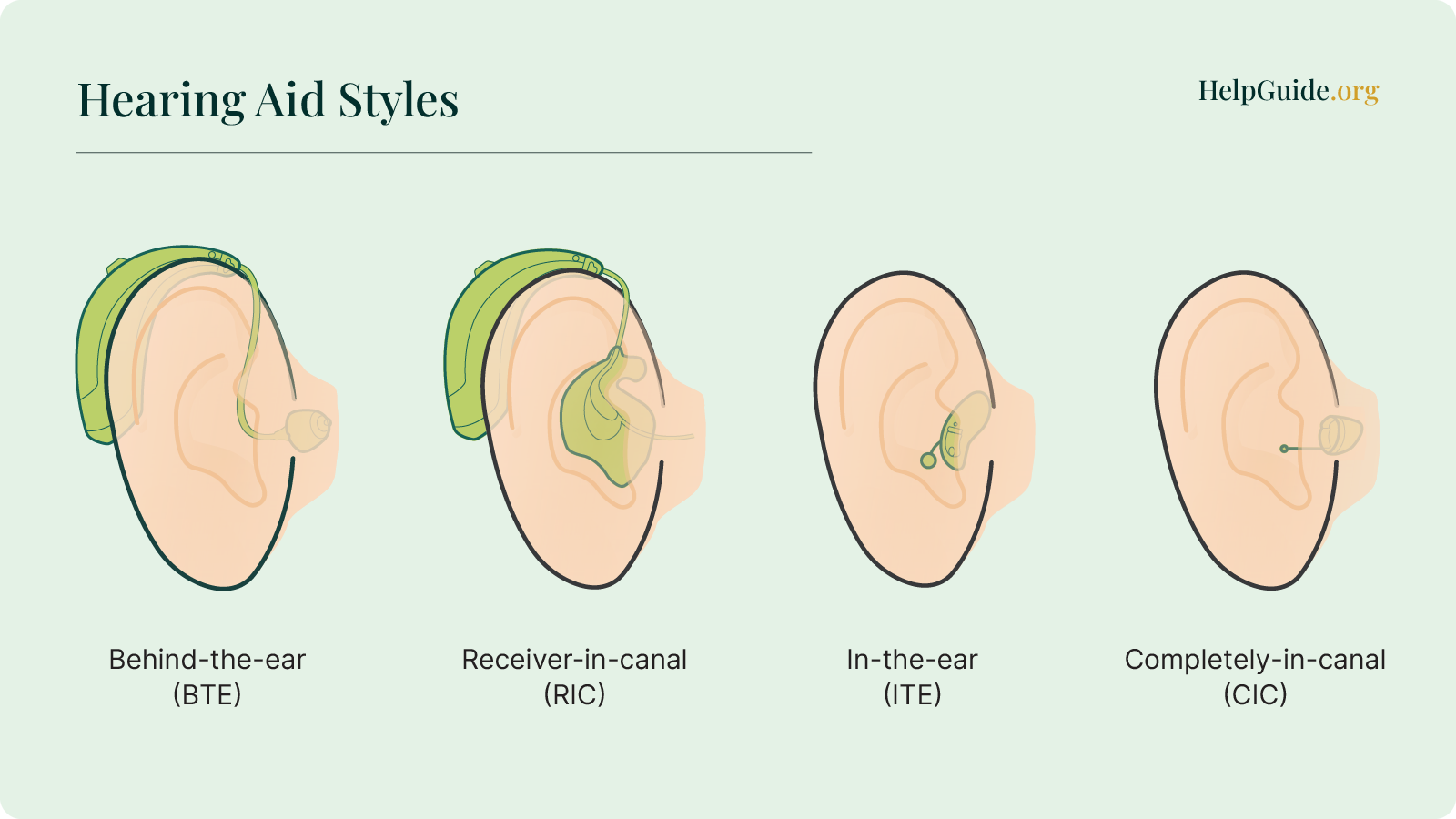
Behind-the-ear (BTE) hearing aids
Good for: Active people, children, people with profound hearing loss
- All working parts fit in a curved case that sits behind the ear, with the amplified sound transmitting to the canal by a thin tube.
- Treats mild to profound hearing loss.
- More durable than hearing aids that sit in the ear.
- Able to incorporate advanced technology and wellness features.
Receiver-in-canal (RIC) hearing aids
Good for: Treating profound hearing loss and people who want a discreet hearing aid with advanced features
- The microphone and amplifier sit behind the ear, and the amplified sound travels through a thin wire to the ear canal, where the receiver transmits it to the inner ear.
- Treats mild to profound hearing loss.
- Often less noticeable than other types of hearing aids.
- Able to incorporate similar technology and features as BTE devices.
In-the-ear (ITE) hearing aids
Good for: People who prefer a hearing device that looks like an earbud
- All working parts fit in the bowl of the ear and ear canal.
- Most aren’t appropriate for profound hearing loss.
- More susceptible to damage from earwax and moisture.
- Offers a range of technology levels and features.
Completely-in-canal (CIC) hearing aids
Good for: People who want an invisible hearing aid or concealed look
- As the smallest hearing aid available, it sits in the ear canal and is removed by a tiny cord.
- Due to their small size, some CIC devices can only treat milder levels of hearing loss and can’t accommodate advanced features or rechargeable batteries.
- Need daily cleaning and routine maintenance.
Hearing aid features
Handbook Team Tip #2
When evaluating hearing aids, ask whether the hearing aid is capable of increasing power so you can still use it if your hearing gets worse.
Technology and features vary widely among hearing aids, and it’s important to evaluate the most important ones to you as you shop for a device. Take a look at some of the most common hearing aid features:
- Digital noise reduction: To reduce background noise. This technology helps isolate and reduce unwanted background noise, improving clarity and comfort for wearers. Noise reduction features are particularly beneficial for individuals in noisy environments like restaurants, offices, or public transportation, as it allows them to focus on conversations.
- Feedback suppression: Cuts down on whistling and squealing from handling or wind noise.
- Battery type: Rechargeable or disposable. Rechargeable hearing aids offer convenient wireless charging but can be more expensive upfront. Disposable hearing aids are cheaper initially but require frequent battery replacements.
- Telecoil: Among our top hearing aid brands in this review, the Lexie Lumen, Phonak Audéo Lumity, Starkey Genesis AI, and Oticon Real offer telecoil options.
- Bluetooth: Bluetooth Low Energy provides direct streaming (meaning you can stream audio directly to your hearing aids) without draining the battery and is now offered in a number of OTC and prescription devices for streaming music, TV shows, and phone calls.
- App compatibility: While all prescription hearing aids have an app for adjusting your hearing aid settings, using Bluetooth, getting remote help from your audiologist, and more, not all OTC devices come with an app. Those that don’t can only be adjusted using buttons on the hearing aids. Hearing aids without an app are quite simple to use, though, and that can be nice for people who don’t have a smartphone or who prefer to adjust their hearing aids without needing their phone nearby.
- Artificial intelligence (AI): AI is a type of machine learning that uses algorithms to “learn” patterns over time. In the case of hearing aids, this means optimally processing the sounds in your environment for a more natural listening experience, better comprehension of speech, and less fatigue.
- Wellness features: Some hearing aids offer additional technology, like heart rate monitoring, step tracking, and fall detection. The Starkey Genesis AI and Phonak Audéo Lumity are top-of-the-line devices that come with wellness features.
Handbook Team Tip #3
Hearing aids can’t restore your normal hearing—don’t trust any company that says otherwise.
Benefits of hearing aids
Hearing aids can improve your ability to hear and understand conversations, but they also offer a surprising number of benefits for overall wellness and quality of life.
“It’s important for people to pay attention to their hearing,” says Kate Carr, president of the Washington, DC-based Hearing Industries Association. “It’s one of our five senses, and while we don’t think twice about wearing glasses, people think for a long time before they address their hearing loss. And when they do, their quality of life improves.”
Our team interviewed Micah Cartee, who personally experiences hearing loss and points out that word recognition can be a big issue for people with hearing aids. “The more you allow your ears not to hear words, the more those things leave your mind, and it can actually hinder your vocabulary and ability to recognize words over time,” he says.
Handbook Team Tip #4
Wear your hearing aids consistently all day, every day. Doing so helps rewire the pathways in the brain that became dormant from untreated hearing loss.
Ruth Reisman, an audiologist and lecturer for the City University of New York in New York City, shared a story of a 41-year-old chiropractor who had difficulty hearing his patients. “He finally accepted that he needed help for his hearing. After being fitted with Starkey Genesis hearing aids, he told me he hasn’t said ‘what?’ once. The hearing aids are improving his quality of life and his family’s, as well as the care he can offer to his patients.”
Natali Edmonds, is a geropsychologist and the founder of Careblazers, an organization that provides support for people caring for someone with Alzheimer’s (a form of dementia). She explains the close relationship between hearing loss and Alzheimer’s.
“There are multiple Alzheimer’s look-alikes. One of them can be hearing loss. So for some older adults, they can look like they have Alzheimer’s, but it could be hearing loss.”
Untreated hearing loss may not only mimic Alzheimer’s but it also raises the risk of other types of cognitive decline. But, wearing hearing aids consistently can improve brain function by reactivating the pathways used to process sound.
How to choose the best hearing aids for you
To find the right hearing aid, you will first need to determine the type of hearing loss you have. After taking an online hearing test, you’ll have a good idea of the grade of your hearing loss. For mild to moderate hearing loss, you can opt for an over-the-counter hearing aid. If your hearing loss is more severe, you should visit a hearing specialist to have a definitive hearing test done and to discuss customized prescription options.
When shopping for an OTC hearing aid, your budget is going to be the first factor that determines your options. Once you’ve established how much you can spend, you can decide on the style. The most common styles are completely-in-canal (CIC), in-the-canal (ITC), behind-the-ear (BTE), and in-the-ear (ITE). Next, compare features, which include the type of battery (disposable or rechargeable), whether it offers Bluetooth streaming or water resistance, and the number of channels and sound environments it offers. Finally, make sure to do your homework regarding the warranty and how much post-purchase customer care will be available to you, as your options are more limited with OTC devices.
When shopping for prescription hearing aids, you’ll find they’re more expensive than OTC models, but over-the-counter hearing aids are not technologically capable of treating more than moderate hearing loss. On the upside, prescription hearing aids offer improved features like water resistance, better Bluetooth streaming capabilities, and more technologically advanced sound enhancements. Plus, you’ll receive more hands-on tech and device support for the life of your hearing aid. Work with your audiologist to find the right fit for your budget, but also prioritize how the hearing aid will look and feel in your ear, and the tech features that are most important to you.
Once you determine your hearing loss grade, your budget, the ideal style, the most important features, and the level of support you need, you will be on your way to finding the best hearing aid for you.
Different types of hearing loss
Hearing loss affects millions of people globally, and it can present itself in many different forms. Understanding the different types of hearing loss is important for choosing the best hearing aid. Here are some of the main types of hearing loss:
- Conductive hearing loss: This type occurs when there’s a blockage or problem in the outer or middle ear, preventing sound waves from reaching the inner ear efficiently.
- Sensorineural hearing loss: This is the most common type of hearing loss, usually resulting from damage to the inner ear or auditory nerve. Age-related hearing loss and noise exposure both go into this category.
- Mixed hearing loss: As you might guess from the name, mixed hearing loss is a combination of conductive and sensorineural hearing loss.
“Hearing loss has really been segmented to an ‘old person’s thing,’ but there are a lot of young people with hearing issues who may not know they have it because they just don’t realize it, they get used to it.” – Micah Cartee
Levels of hearing loss
Hearing loss is typically categorized into severity depending on how soft sounds you can hear. This is measured in decibels (dB) and helps determine what hearing aids might work for you.
Here’s a breakdown of the common levels of hearing loss:
- Normal Hearing (0-20 dB): If your hearing falls within this range, you have normal hearing and can perceive sounds quietly spoken at a conversational distance (around 6 feet).
- Mild Hearing Loss (21-40 dB): At this level, you might have difficulty hearing faint sounds like whispers or birds chirping. You may also struggle to follow conversations, especially in noisy environments.
- Moderate Hearing Loss (41-60 dB): With moderate hearing loss, you likely miss many everyday sounds, like a normal conversation at a distance or the ringing of a doorbell. Speech may sound muffled, and following conversations can be challenging.
- Severe Hearing Loss (61-80 dB): At this level, difficulty understanding speech becomes significant. You might only be able to hear loud or amplified sounds clearly.
- Profound Hearing Loss (81 dB and above): With profound hearing loss, you may have very limited hearing or be unable to detect sounds without amplification.
Hearing aids for tinnitus
Tinnitus is a condition that causes you to “hear” ringing, buzzing, or other sounds in the absence of any external sounds. It can be very bothersome and disrupt daily life. While there is no cure for tinnitus, hearing aids can help many sufferers manage their symptoms. Some hearing aids even come with built-in tinnitus masking features.
Over-the-counter hearing aids vs. prescription hearing aids
Over-the-counter (OTC) hearing aids are a relatively new category, approved by the FDA in August 2022. These hearing aids are designed to support adults with perceived mild to moderate hearing loss. They can be purchased online or in stores without requiring users to see a physician for an exam, prescription, or professional fitting and adjustment, increasing accessibility and affordability.
Unlike OTC hearing aids, prescription hearing aids can treat all levels and types of hearing loss. While prescription hearing aids require an evaluation and fitting by a hearing professional, they also offer improved sound technology and a range of design and style options.
Pros and cons of OTC hearing aids
Pros and cons of prescription hearing aids
How to buy the best hearing aids
Handbook Team Tip #5
When purchasing hearing aids through a third-party retailer, be sure to compare the warranty terms with the manufacturer. You may get better terms if you purchase directly.
In years past, a visit to an audiologist or other hearing specialist was required before buying hearing aids, and you could only get them from those professionals. That has changed in the past few years, with the FDA passing a final rule on OTC hearing aids, which went into effect last October, creating regulations and opening the market to both online and brick-and-mortar retailers.
Hearing healthcare professionals’ offices
Audiologists, otolaryngologists (ENTs), and hearing instrument specialists can dispense prescription hearing aids following a professional hearing evaluation. In most cases, these professionals also provide ongoing care and adjustments to your hearing aids.
Hearing aid dispensaries
These are small retail stores that specialize in hearing aids. They may also employ hearing professionals who can conduct hearing tests (though these aren’t always audiologists). Selection likely depends on the dispensary.
Online retailers
Certain online retailers offer OTC hearing aids. These often come with self-fitting options and pre-programmed settings. Often, they don’t require a prescription or professional fitting. It’s important to choose a reputable retailer.
Manufacturer website
Some hearing aid manufacturers may allow direct purchases of their hearing aids through their website.
How much do hearing aids cost?
It is typical to spend more on prescription hearing aids than you would on over-the-counter hearing aids. Prescription hearing aids are customized to your hearing loss by an audiologist. Phonak and Starkey, along with Oticon, ReSound, Signia, and Widex, come with more sophisticated sound technology, greater amplification power, and often more features than OTC hearing aids. They also offer the option of in-person service, which isn’t available from most OTC hearing aid manufacturers.
We talked with Kate Carr, president of the Washington, DC-based Hearing Industries Association, about the difference between OTC and prescription hearing aid prices. “It’s the technology along with the services that drive the cost,” says Carr. She also pointed out that a person’s needs and preferences can influence which type of hearing aid is a better fit for them.
Part of it depends upon the individual. Some people need highly individualized services, and some people are able to do this on their own.
Kate Carr, president of the Hearing Industries Association
When shopping for hearing aids, think about your personal preferences, budget, and level of hearing loss to help in your decision-making process.
Are hearing aids covered by insurance?
Hearing aid coverage by insurance varies depending on your specific plan. Many private insurance plans and Medicare Advantage plans may offer some coverage of hearing aids, but traditional Medicare does not cover them. Health Savings Accounts (HSAs) and Flexible Spending Accounts (FSAs), however, can be used to pay for hearing aids if they are qualified medical expenses under your plan.
Are hearing aids covered by medicare and medicaid?
Traditional Medicare Parts A and B do not cover hearing aids. However, some Medicare Advantage plans, which are offered by private companies, may include hearing aid coverage. Medicaid, a government program for low-income individuals, may cover hearing aids for adults and children in some states. Coverage specifics vary depending on your state’s Medicaid program.
Hearing aids financing
Every hearing aid brand listed in this review, as well as all hearing care clinics, offers at least one financing option. Some companies handle their own financing, while others use a third party, such as Bread or Allegro.
Handbook Team Tip #6
If using third-party financing, check interest rates first – some charge up to 35% interest, depending on your credit score.
Hearing aids financial resources
Hearing aids are an expensive purchase, costing upwards of $1,000 in many cases. The good news is that a variety of organizations offer assistance for those who need help paying for them, including:
- Hearing Aid Project
- Help America Hear
- American Speech-Language-Hearing Association
- Hearing Industries Association
- Hearing Loss Association of America
- National Institute on Deafness and Other Communication Disorders
New hearing aid technology in 2024
2024 and beyond will most likely bring new and improved hearing aid technology, upgrading the devices in both design and function. Some of the advanced technology hearing aid users may see include:
- Integrated Artificial Intelligence (AI): AI may be used to automatically filter sounds for hearing aid users, amplifying noises users want to hear while reducing background noises more effectively. AI algorithms can also build a more personalized listening experience and predict feedback to stop it before it starts.
- Advanced features: AI may also offer advanced features, such as language translations, auto-correction, and even captions.
- New designs: Improved technology means hearing aid design is also changing. For instance, some aids will become smaller, lighter, and more streamlined. Some hearing aids will also be built into other devices, such as a new type of glasses with hearing aid technology built in.
- More OTC options: AI means even advanced hearing aids may become more readily available for over-the-counter (OTC) shoppers.
- Auracast technology: Auracast already exists, but the expansion of the technology will allow more users to access it. Auracast allows hearing aid users to bypass their phone as a pass-through technology to adjust settings and have access to advanced features like hearing muted audio in public, audio sharing with multiple listeners, and streaming at concerts or other public venues.
Our hearing aid testing experience




After our Handbook Team hand-tested 27 hearing aids, mystery shopped 11 brands, and gathered insights from hearing professionals, eight stood out as the best hearing aids on the market.
Our testers tried multiple devices and answered a checklist of 25 questions about each. We used these answers to look for outstanding performers. The process looked like this:
We encountered a number of surprises during the testing process. Batteries that were hard to change, hearing aids that didn’t stay in our ears, distracting background noise, confusing user manuals, and customer service marked by long wait times were among the biggest drawbacks of certain brands.
But we were impressed with the helpful audiology support, fine-tuning adjustments, Bluetooth streaming, and user-friendly apps offered by other hearing aid companies.
From our tester
“I was very pleased by how easy certain hearing aids and their accompanying apps were to set up and use but surprised by the poor quality of other devices. Only by hand-testing each model did I uncover the small details of each hearing aid that can make all the difference when you’re using this type of device every day.”
Our experts selected the top three OTC hearing aid brands for their stellar products and service. Keep in mind, OTC hearing aids are only appropriate for adults 18 and over with mild to moderate hearing loss, and they can be purchased and set up without help from a hearing professional.
Prescription hearing aid companies offer a greater variety of models for all degrees of hearing loss. We chose our favorite model from each of the three top brands based on our testing results. You’ll need to visit a hearing care clinic and have an in-person hearing exam before buying a prescription hearing aid. Read on to see which of our picks is the best choice for you.
Learn more about our hearing aids review methodology.
Our final verdict
If you think you may have hearing loss, get your hearing tested as soon as possible. People with mild or moderate hearing loss could be great candidates for OTC hearing aids. Jabra Enhance, Lexie, and MDHearing are among our top picks in this category for their comfort, ease of use, ability to improve hearing at an affordable price, and outstanding remote audiology support.
If you have severe or profound hearing loss, or even less significant hearing loss but want a device with higher-end technology or in-person help from an audiologist, look into prescription devices like the Phonak Audéo Lumity, Starkey Genesis AI, or Oticon Real.
The most important thing to remember is that hearing health is directly tied to brain health and overall quality of life. Addressing hearing loss can be a big step, but the rewards will be lasting and worth every penny.
Frequently asked questions
From our testing and research, we’ve ranked Jabra Enhance as the best OTC hearing aid brand. We like the high-end sound quality, the Bluetooth streaming capabilities available in every aid, and the top-notch customer service. Phonak’s Audéo Lumity model is our choice for the top prescription hearing aid. We like this device for those who need hearing help in large public spaces, thanks to its advancements for challenging listening environments and the amount of accessories available.
As with many tech devices, you get what you pay for, and hearing aids are no different. Those with a higher price tag will incorporate more features and often better sound processing abilities to give you a more natural listening experience.
You can buy a decent set of OTC hearing aids for $500, a mid-grade set for $1,600, and an advanced pair for almost $3,000. The prices for OTC hearing aids depend on the sound quality features and sound environments addressed, as well as whether they have Bluetooth capabilities. OTC hearing aids are best for people with mild to moderate hearing loss. Prescription hearing aids, on the other hand, are more expensive. These aids start in the $2,300 range, increasing to around $5,450 per pair. Prescription hearing aids offer significant technological advancements for the treatment of severe hearing loss and are fully customized and programmed to your hearing needs.
Buying OTC hearing aids online is sometimes less expensive than buying prescription hearing aids from a hearing clinic. But high-end OTC devices often cost the same or even a few hundred dollars more than entry-level prescription hearing aids.
Also, the price of prescription devices usually includes one to three years of in-person audiology support, while OTC hearing aids are meant to be set up and used by the consumer without professional support. Some companies provide remote audiology services for customers at no extra charge, but others only offer general customer service help.
Expect to get about five years out of a pair of hearing aids before needing to replace them. By that point, the technology will also have advanced such that you’ll have a better listening experience with a new pair.
At a hearing aid fitting, the audiologist will do the following:
- Show you how to correctly fit the hearing aids in your ear.
- Program your hearing aids to match your audiogram (hearing test results).
- Check your hearing with the newly programmed hearing aids.
- Explain and demonstrate how to make volume and listening setting adjustments, how to connect to the hearing aid app on your phone, how to use the Bluetooth function, how to charge your rechargeable hearing aids or change disposable batteries, and how to clean and maintain them.
Your audiologist may also propose an aural rehabilitation program to support your continued success with hearing aids.
The main difference between over-the-counter (OTC) and prescription hearing aids is that OTC devices can be purchased easily through retailers, while prescription aids require an examination and prescription from a hearing health professional. Additionally, OTC hearing aids, which treat mild to moderate hearing loss, are typically lower in cost than prescription hearing aids, which are more technologically advanced for the treatment of severe hearing loss. Plus, prescription hearing aids come with better customer support since they are tailor-made to treat each person’s specific type of hearing loss.
When it comes to caring for your hearing aids, make sure to first review the instructions provided by the manufacturer. Your new hearing aids may come with their own set of cleaning tools for self-maintenance, but not all do, so you may have to buy the supplies yourself. Either way, make sure to learn about the right tools to use based on your hearing aid’s design—for example, which tools and solutions are best for cleaning ear wax and debris without damaging the plastic or metal components. Alcohol, when used as a cleaning agent, can corrode or damage your hearing aids or charging case. If you opt for an “invisible” hearing aid, on the other hand, it will likely be placed in your ear by a professional and will not require cleaning or care by you; instead, the device is replaced every few months.
- Hearing Loss Facts and Statistics. (2021, June) Hearing Loss Association of America. Link
- The hidden risks of hearing loss. (2022, November 1). Johns Hopkins Medicine. Link
- Medical devices; ear, nose, and throat devices; establishing over-the-counter hearing aids. (2022, August 17). Federal Register. Link
- Public Health and Scientific Information | NCEH | CDC. (2018, December 11) Link
- Are you hearing everything you could? (2019, September). Hearing Loss Association of America. Link
- Attorney general sues over-the-counter hearing aid company Nano for misleading consumers. (2023, January 3). Office of the Vermont Attorney General. Link
- Lin, F. R., Pike, J. R., Albert, M., Arnold, M., Burgard, S., Chisolm, T. H., Couper, D. J., Deal, J. A., Goman, A. M., Glynn, N. W., Gmelin, T., Gravens-Mueller, L., Hayden, K. M., Huang, A., Knopman, D. S., Mitchell, C., Mosley, T. H., Pankow, J. S., Reed, N., . . . Coresh, J. (2023). Hearing intervention versus health education control to reduce cognitive decline in older adults with hearing loss in the USA (ACHIEVE): a multicentre, randomized controlled trial. The Lancet, 402(10404), 786–797. Link
- American Speech-Language-Hearing Association. (n.d.). The Audiogram. Link
- What is aural rehabilitation (also called aural rehab or A.R.)? (2021, August 16). Hearing Loss Association of America. Link







